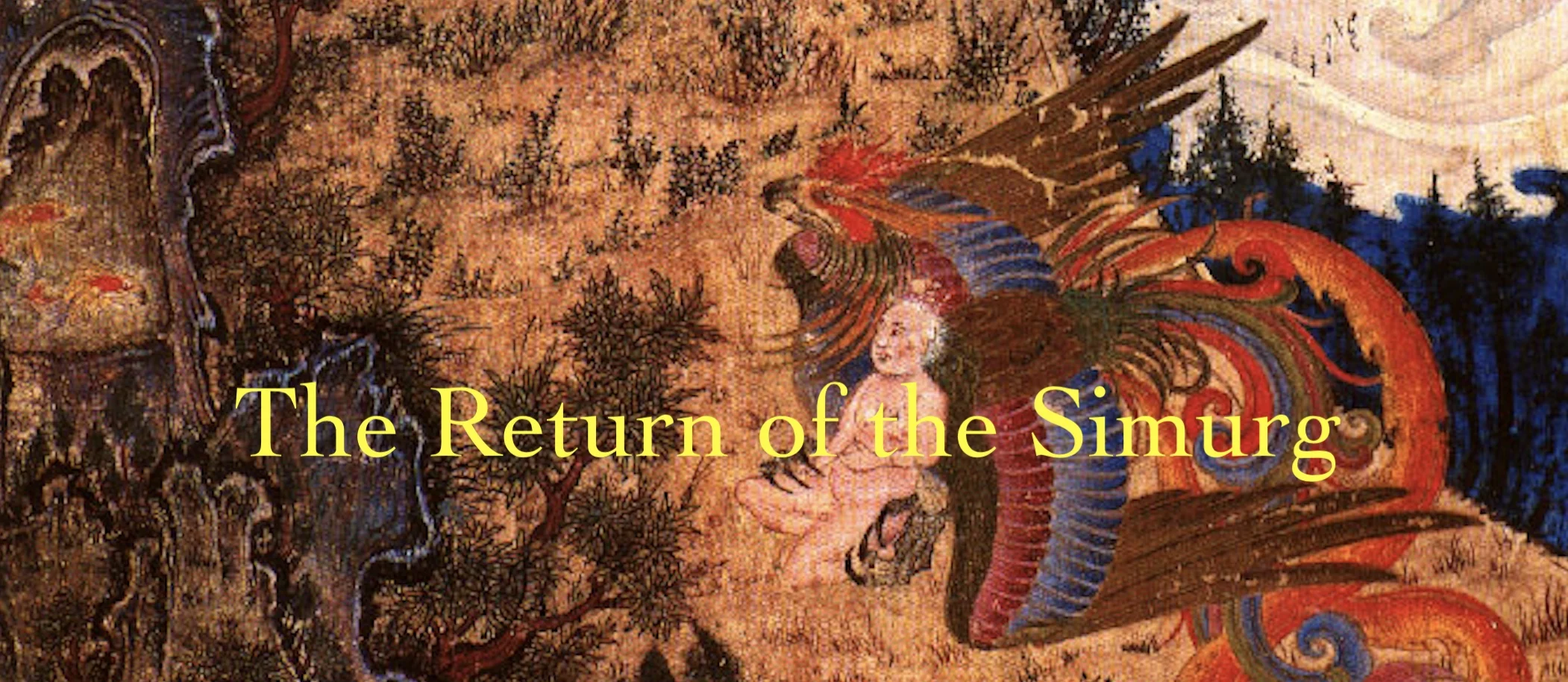The Double Refuge 🇮🇳 The Fiction of Doubt
The Return of the Simurg
🇮🇳
I started this chapter with the notion that Rushdie’s fiction, from Grimus to Haroun, is deeply influenced by the spiritual journey in Attar’s Conference of the Birds and by the figure and mystical meanings of Attar’s Simurg. In this final section I’ll trace the shift from positive to negative takes on the Simurg, showing how the ideal of unity becomes ever more remote, until it’s extinguished in Shame and The Satanic Verses. This doesn’t, however, mean that the ideal isn’t still important. I’d argue that it’s more important than ever: when intolerant and anti-democratic forces extinguish freedom, the symbols of freedom become even more powerful. The same operates with Rushdie’s use of Attar’s Simurg and Conference: the Simurg becomes an increasingly esoteric symbol of unity between people: the si murgh (thirty pilgrim birds) implodes more silently into the Simurg (God) on top of Mount Qaf. Likewise, the Conference becomes an increasingly muffled reference to the free and open debate that occurs in any civilized society before a community makes a decision.
I should note here that the first half of this chapter introduce Rushdie’s early novels. The next half takes a more detailed look at the main characters in his first four novels. I already looked at his fifth novel, Haroun & the Sea of Stories, in 🇮🇳 Rushdie’s Sea of Stories; A Tale of Birds & Fishes (at the end of ♒️ A River Journey).
🇮🇳
The symbol of the Simurg works admirably in the theoretically conflated worlds of Grimus, yet the mythic bird has a hard time flying, or even getting off the ground, in the history-laden world of Midnight’s Children. While Grimus is structured along the epic and mystic paths of Dante and Attar, Midnight’s Children is structured along the parallel lines of a family history and a national history. It's also structured more obscurely and obliquely on a mythic cycle, starting with a fall from a symbolic (yet far from perfect) Eden, and ending with a possible return to this Eden. Whether the forces of peaceful unity or violent division will win is not clear. While Saleem is himself pessimistic, Rushdie subtly links the Arabian Nights’ magic number (1001) and the magic number of 30, which Attar uses to indicate the birds who find mystical unity and annihilation on the peak of Qaf. Salem writes his account at the age of 30, the post-Raj subcontinent is 30 years old, and Saleem sees his 30 chapters as 30 pickle jars filled with his rambling, spicy stories. Since Saleem’s predecessor, Scheherazade, obtains her freedom after telling 1001 tales, Saleem and his beloved subcontinent may also find some measure of freedom in his “thirty jars and a jar” (461) — that is, in the hypothetical après-tale which symbolizes more than the sum of the parts.
In Shame Rushdie narrows his focus from the subcontinent to Pakistan, schematizing the life of three families rather than expanding on the lives of one. Shorter than Midnight's Children, Shame chronicles the frightening emotional landscape of the doctor Omar Khayyam Shakil, as well as the political careers of Iskander Harappa and Raza Hyder, fictional versions of Ali Bhutto and Zia ul-Haq (Rushdie's main argument is that Iskander’s authoritarianism paves the way for Raza’s religious dictatorship). Whereas Saleem retains some of his early idealism to the bitter-sweet end of the novel, Omar’s visions are immediately overwhelmed by sinister forces: not only do his three witchy mothers remove from his life an exquisite screen depicting Qaf and its 30 birds; they also work in concert with the Beast, Kali, and Madame Guillotine to wreak vengeance on the patriarchal world around them — a world that very much includes Omar the opportunistic pedophile. The novel slides further into a nightmare of darkness, as Omar’s child-wife Sufiya is possessed and raped by the Beast, and Omar is brought face to face with the horror he feared in his youth.
Rushdie's second, third and fourth novels constitute a loose subcontinental trilogy, ending with The Satanic Verses, in which characters travel back and forth from India to England, and in which the main characters are possessed, destroyed, or otherwise manipulated by the Devil. Yet in the Verses Rushdie pushes the role of the Devil even further: he allows a satanic narrator to swoop in and out of a text which is charged with demonic revisions of cosmology and the increasingly hellish visions of a schizophrenic who half-believes he is an archangel. The conclusion highlights the triumph of cosmic evil: in a masterfully designed triple parallel, Chamcha/Satan/Iago drives Gibreel/Adam/Othello to murder Alleluia/Eve/Desdemona. Yet the scenario is not all dark: the confluence of Shakespeare’s pathos and Attar’s symbolism (seen in Sufyan and in Allie’s yearning to climb Everest) hints at a deeper ideal of unity and love.
Rushdie returns with a bang to the positive syncretism of Grimus in his fifth novel, Haroun and the Sea of Stories (1991). While Haroun isn’t simplistic, it’s less complex than Grimus, the most idealistic and syncretic of his previous novels. Haroun uses the same syncretic mode to highlight the ideal of multidimensionality, yet it doesn't contain the same profusion of myths and loose ends, ambiguous characters like Deggle, Virgil and Grimus-Eagle, and it doesn't delve into dark and problematic visions of the universe. And while Grimus ends in paradoxes and conundrums, Haroun ends with a neat fusion of paradigms, a happy ending that’s clearly in the comic and fairy tale mode. For a detailed look at the way Rushdie fuses the Muslim ideal of conference and unity with the Hindu ideal of free expression and infinite narrative, see 🇮🇳 Rushdie’s Sea of Stories; A Tale of Birds & Fishes, in the previous chapter, ♒️ A River Journey.


